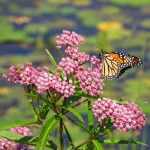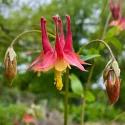Highlights
The name is so strange, but the plant is so beautiful! Obedient plants send up tall (3-5 foot) stalks, then cover the stalks with a runway of pink or purple flowers, each the perfect-sized cup for a pollinator to dive into. Obedient Plants have a reputation for being invasive and taking over gardens, but taking care to divide or remove shoots in the spring can keep them in check. They love sun, flower for a month in the summer, and are very drought tolerant. See below for tips and planting inspiration.

Dig Deeper
Explore the history, types, and where to plant native Obedient Plants
Table of Contents
Get ready to add some show-stopping color and pollinator appeal to your garden with the stunning Obedient Plant (Physostegia virginiana)! Also known as False Dragonhead and Virginia Lions-heart, this native North American perennial is known for its striking tubular flowers that come in shades of pink, white, and purple. In this article, we’ll explore everything you need to know about planting, caring for, and utilizing this must-have native flower.
Why is it called Obedient Plant?
Obedient plant is a very strange common name! Obedient Plants’ name comes from the ability to bend their flowers: you can (gently!) take an Obedient Plant’s flower and bend it to face upwards, downwards, or to the side. The plant will then remain in that position for a few hours or days (eventually, the flower moves back in the direction of the sunlight.)
What are the benefits of planting Obedient Plants?
Obedient Plants are striking for several reasons:
- Obedient plants are tall. Each plant sends up a single tall stalk with sparse leaves. They are majestic, especially when a few are planted together.
- Their buds look celestial. Their green buds run to the top of the plant, looking similar to a comet streaking across the sky.
- Their flowers look bridesmaid dress-inspired. Their flowers are long-lasting and gorgeous. Each petal-cup is decorated with tiny freckles and a halo of lighter coloring.
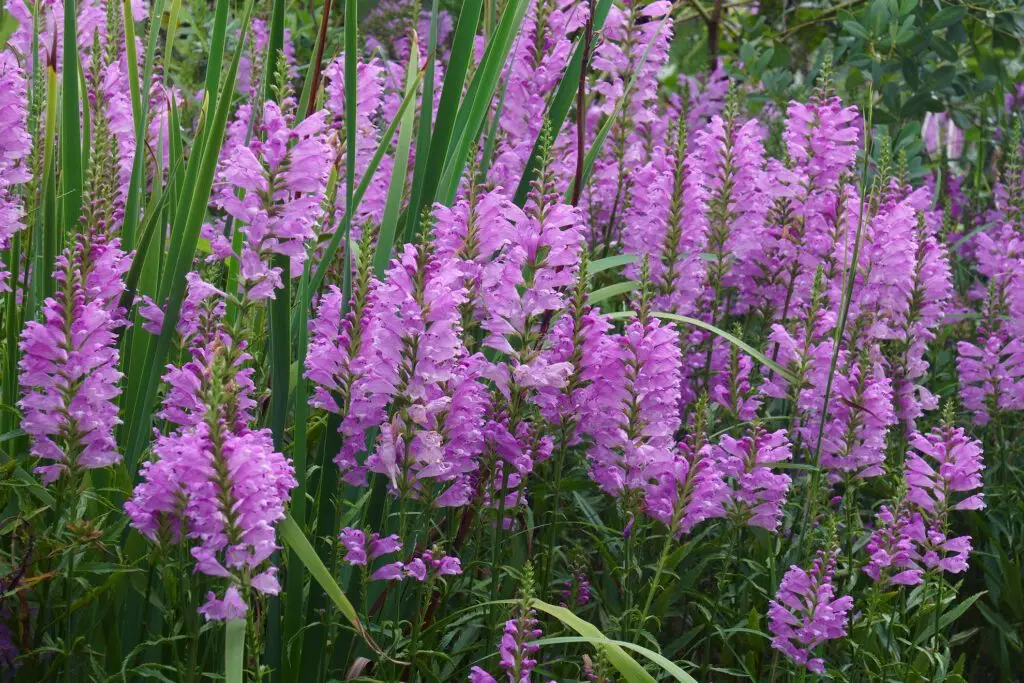
Is Obedient Plant invasive?
While Obedient Plant is generally a low-maintenance plant, there are some potential drawbacks. One of the main concerns is that the native variety can spread aggressively and become invasive in some regions. To help keep Obedient Plant from taking over your garden:
- Divide the plant every few years (‘dividing’ means digging up some plants)
- Pull up individual shoots + roots in the spring to ensure air and space for other plants
Either of these methods is still low maintenance—especially compared to lawn care. (Although it does take a few Advil after I pull out their roots and shoots in the spring.)
If this yearly work seems annoying, we get it! Consider planting other natives that have less invasive tendencies, like Blazing Star, coneflowers, Rattlesnake Master, Culver’s Root, and Purple Prairie Clover.
One more concern to mention:
Warning if planting near water!
If you’re planting the Obedient Plant in a wetland area, check with local authorities or your native plant society to ensure that it’s not considered an invasive species in your area. In a wetland area, it can be almost impossible to stop the seeds from spreading throughout the water source and its banks. Its invasive status changes throughout the United States; a quick Google search for your county or state + “obedient plant” should get you the answer.
Want to plant Obedient Plants and not worry about invasiveness?
Consider planting a cultivar:
Obedient Plant cultivars
There are Obedient Plant cultivars that will help keep the plant’s spreading in check, as some cultivars have been bred not to spread as aggressively. (Wondering what a cultivar is? Here is a quick cultivar overview.) Here are some to consider:
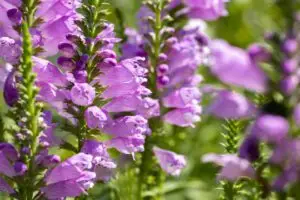
Obedient Plant 'Vivid'
‘Vivid’ is a purple-flowered long-bloomer that’s less tall than the native species (2′ in height). ‘Vivid’ is a long-blooming variety that often flowers well into autumn.
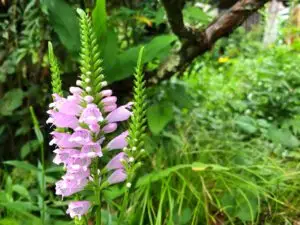
Obedient Plant 'Pink Manners'
Pink Manners is a non-spreading, clump-forming, native perennial that’s less tall than the native species (2′ in height), with long season of pink flowers (June-Sept).
How to grow Obedient Plants
Obedient Plant is a hardy plant that can tolerate a range of growing conditions, including sun, shade, and moist or dry soil. However, it prefers well-drained soil and full sun to part shade for optimal growth and blooming. (Just stay away from full shade for Obedient Plants.)
Where can I find seeds and plants?
Finding native plants can be challenging (we partly blame Marie Antoinette.) To make it easier, we’ve assembled four sourcing ideas.
Native Plant Nurseries
Our list of native nurseries makes finding one a breeze
Online Native Plant Sellers
We've included 100+ online resources to help
Society Plant Sales
Every state has a native plant society; find yours
Online Communities
Local Facebook groups are a great plant source
Online Obedient Plant seed sources
Many online seed shops sell Obedient Plant seeds, including:
- Outside Pride (Salem, OR) sells both pink and white Obedient Plant seeds
- Swallowtail Garden Seeds (Santa Rosa, CA) sells seeds of the white ‘Crystal Peak’ cultivar
- Swallowtail Garden Seeds (Santa Rosa, CA) sells 25 seeds of the pinkish-purple ‘Rose Crown’ cultivar
What to plant with Obedient Plants
Obedient Plants are excellent companions for other sun-loving native flowers like:
Obedient plants are beautiful and easy-to-grow plants that are a great choice for full-sun or partial-sun gardens. By following the simple care tips we’ve shared, you can enjoy its striking blooms for years to come. To get more ideas on native plant gardening, explore our native plant library. Happy planting!
